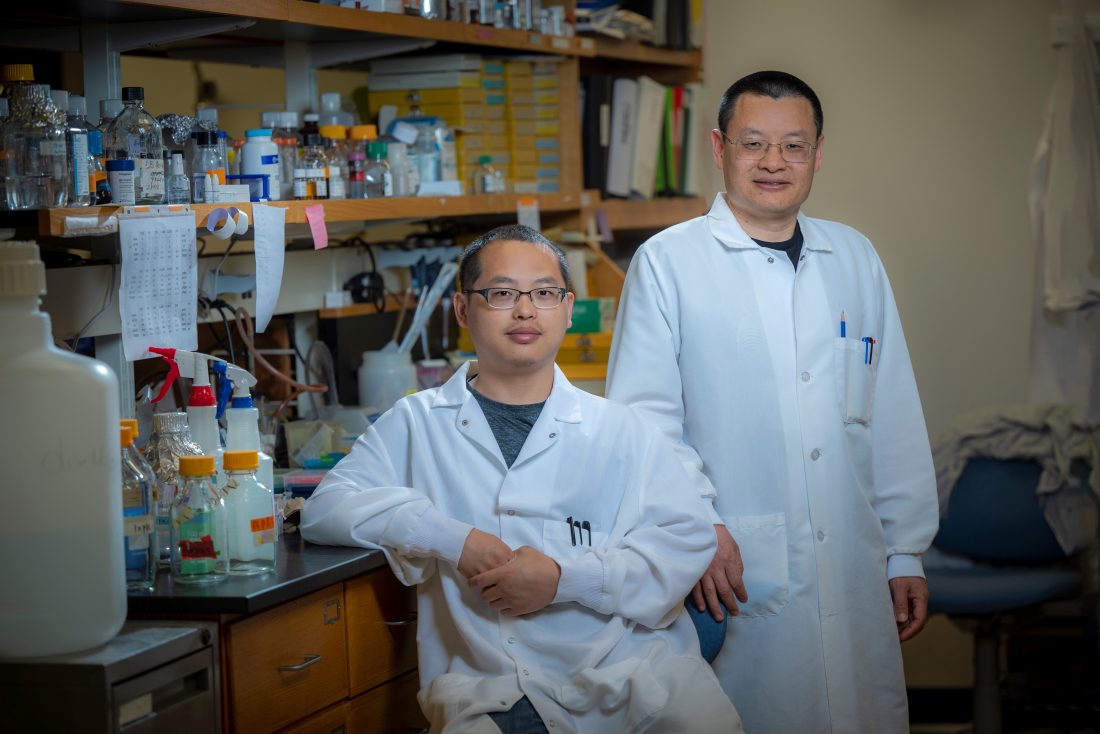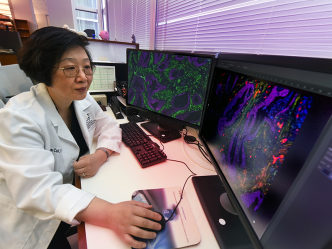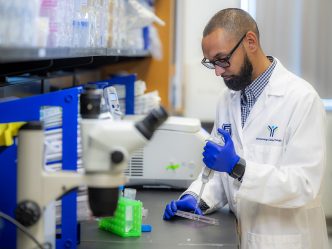A long molecule of RNA found in abundance in the healthy smooth muscle cells that give our blood vessels strength and flexibility is also essential to the continuous contraction that moves food through our gastrointestinal tract.
Without CARMN, a long noncoding RNA, which means it doesn’t produce proteins but does help regulate cell activity, the 30-foot-long GI tract doesn’t contract as it should.
That can result in a painful even lethal situation where partially undigested food gets trapped, said Jiliang Zhou, PhD, vascular biologist in the Department of Pharmacology and Toxicology at the Medical College of Georgia at Augusta University.
“CARMN is a key regulator of contractility in both places, and, when it’s not functioning optimally, we don’t function optimally,” said Zhou, corresponding author of the study published in the journal Gastroenterology.
He and his colleagues reported in 2021 in the journal Circulation that CARMN is the only long noncoding RNA consistently abundant in human vascular smooth muscle cells in the blood vessels of both humans and mice. They also found that its presence is distinctly diminished in vascular disease, like atherosclerosis. And, when they restored more normal levels in mouse models of vascular disease, scar formation and unhealthy cell proliferation inside the blood vessels were dramatically diminished.
During that work, the scientists realized CARMN’s essential role in the movement of the GI tract, which includes our swallowing tube, or esophagus, stomach and intestines.
Zhou notes that CARMN actually appears more critical in the GI tract than to the flow of blood through our blood vessels because the beating heart is a force that can keep blood moving.
“A consequence of the dysfunction of the contractility of GI smooth muscle cells would be much more severe than the vascular smooth muscle cells. It’s critical to their constant function,” Zhou said. “You take it for granted, but if it’s not doing it, you have problems.”
While it has been clear that trouble with movement of the GI tract can be problematic, even deadly, details about what controls the smooth muscle cells that regulate this essential movement have been unclear, the MCG scientists said.
Visceral smooth muscle cells are a component of the GI tract that is essential to what is called motility, or movement, Zhou and his colleagues wrote. That action is essential to the movement of food through the GI tract. Impaired movement can result in varying degrees of intestinal pseudo-obstruction. With this condition, partially digested food builds up in the intestines, causing abdominal swelling and pain, nausea, vomiting and constipation or diarrhea, according to MedlinePlus. This may impact the bladder and the ability to urinate, as well as the uterus, which must produce powerful contractions to enable a baby’s birth.
Zhou and his colleagues were pursuing their primary interest in the vascular smooth muscle cells by knocking CARMN completely out to look at the consequences when they discovered this unexpected role in the GI tract. They found that, without CARMN, 100% of the time, mice would not survive and/or experience bloated bellies because the GI tract no longer contracted as needed.
“This was unexpected,” he said. They found that the loss of CARMN resulted in downregulation of multiple genes that enable contractility, like Mylk, an established key regulator of smooth muscle cell contraction. It also disrupted the communication and coordinated action of GI cells that enables them to work “like an orchestra” to make meaningful movement happen. The same responses occurred in both mouse models and human GI cells. Zhou also said that the loss interfered with their pursuit of better understanding the long-term consequences of altered CARMN levels in the vascular smooth muscle cells.
Their new findings point to the need for a tool to selectively remove CARMN. They are pursuing possibilities like the gene-editing tool CRISPR in collaboration with Joe Miano, PhD, genome editor, molecular biologist and J. Harold Harrison, MD, Distinguished University Chair in Vascular Biology, and Benard Ogola, PhD, pharmacologist, both at the MCG Vascular Biology Center. They also want to explore more simple potential approaches to increasing CARMN levels, like exercise.
They now want to look at CARMN in the GI cells of people with intestinal pseudo-obstruction to try to determine whether it’s lower expression or whether there is a mutation that has altered its function.
Smooth muscle cells are found in the walls of passageways in the body, like the GI tract, as well as hollow organs like the bladder. The MCG scientists’ animal models enable them to pinpoint exactly where CARMN is, and it’s only inside smooth muscle cells, Zhou said. He noted there likely is some variability in CARMN expression in different individuals and in the specific location of the smooth muscle cells. In fact, that expression may change, for example, in the uterus during pregnancy.
There is little doubt that CARMN expression decreases with age, but they have not yet explored that. They are currently developing a mouse model that overexpresses CARMN to see the consequence of that extreme. They also are now exploring CARMN’s potential role in weak points in blood vessels called aneurysms, which can result from problems like atherosclerosis and infection, and can rupture and potentially be fatal as well.
The Human Genome Project, which concluded in 2003, indicated that the vast majority of our RNA, like CARMN, is noncoding RNA, although these RNA have been the least studied to date.
Postdoctoral Fellow Xiangqin He, PhD, is first author on the new study and is supported by a postdoctoral fellowship from the American Heart Association. The research was supported by the National Heart, Lung and Blood Institute, as well as an Established Investigator Award and Transformational Project Award from the AHA to Zhou. Coauthor and former Postdoc Kunzhe Dong, PhD, who is now a faculty member in MCG’s Immunology Center of Georgia, is a recipient of a Career Development Award from the AHA.
Read the full study.
 Augusta University
Augusta University





